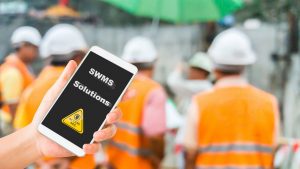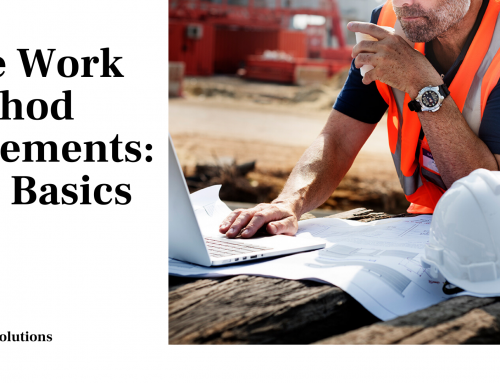Tailored Safe Work Method Statements help you create a safer workplace. Learn about the four essential components of a SWMS with this Access SOS guide.
In Australia, the construction sector has the third for the number of incidents in the workplace and number of fatalities -just after the agriculture and transport sectors.
Only in 2020, there were 17 fatalities just in the construction industry, most of which could have been prevented and avoided. While recent regulations have helped reduce the number of injuries in the workplace, there is still a lot to do to make companies in the construction sector safer workplaces.
Safe Work Method Statements (SWMS) are custom-made documents that aim to help businesses identify high-risk work areas, pinpoint hazards, and implement, monitor, and review health and safety measures.
Each SWMS is tailored and specific to each workplace, but they all follow standard outlines. Here are the four elements that should always be included in your construction company’s SWMS.
Identification of High-Risk Construction Work
 A SWMS’s primary aim is to identify the work areas with substantial risk for supervisors, owners, and employees alike. These high-risk tasks, activities, or work environments are different for every business, especially in the construction industry.
A SWMS’s primary aim is to identify the work areas with substantial risk for supervisors, owners, and employees alike. These high-risk tasks, activities, or work environments are different for every business, especially in the construction industry.
As reported by Safe Work Australia, since 2012, the Work Health and Safety Regulations recognise 18 high-risk construction work activities that will require a PCBU (Person Conducting a Business or Undertaking) to implement a SWMS.
These 18 high-risk construction work (HRCW) activities help define most of those tasks and daily work with identifiable risks. In most SWMS templates, you will find a list of these activities and check which high-risk task occurs in your workplace.
These can be summarised in four main categories:
- Tasks that involve involves therisk of a person falling more than 2 metre.
- Tasks in an area at a workplace in which there is movement of powered mobile plant.
- Tasks carried out on or near energised electrical installations or services.
- Tasks that demolition of a structure that is load-bearing or otherwise related to the physical integrity of the structure; as well as work carried out in or near a confined space.
A SWMS is often required in construction businesses carrying out any of the tasks above. Still, there might be exceptions for “work of a minor nature”. Ultimately, the first section of your SWMS risk assessment should help you identify the works and activities carried out in your business that involve significant health and safety hazards.
Specification of Hazards and Health & Safety Risks
Once you have used the 18 high-risk construction work (HRCW) activities framework to identify your business’s work areas, your SWMS will help you understand what risks can arise from these activities.
his second section of your SWMS is dedicated to specifying the potential hazards related to the high-risk activities pinpointed in the first section and help you understand how control methods can be used to reduce the exposure and who is the responsible person or persons to make the changes on your site.
 These potential hazards don’t just include areas of immediate and obvious risk. They also help you understand what risks are involved with the long-term use of a Plant (type of machinery), their malfunctioning, and specific actions or mechanical failure that cause high-risk in site tasks. Your risk assessment should also mention the likelihood and consequence for each hazard to happen including the risk to your business.
These potential hazards don’t just include areas of immediate and obvious risk. They also help you understand what risks are involved with the long-term use of a Plant (type of machinery), their malfunctioning, and specific actions or mechanical failure that cause high-risk in site tasks. Your risk assessment should also mention the likelihood and consequence for each hazard to happen including the risk to your business.
Depending on your risk assessment, you might also note your assumptions regarding the workplace and your employee’s qualifications. Making assumptions that all machinery and tools are properly maintained, and your employees’ training is kept up to date, might well be a key hazard just waiting to turn into a work incident.
Nonetheless, it is important not to underestimate factors that are often out of your control, including human error or tiredness.
Description of Control Measures To Implement
Thanks to your SWMS, you should now have a better understanding of what risks are involved with your daily activities and what complications might arise from them. Once you have completed the first two sections, you will need to describe the risk control measures implemented to prevent, avoid, or minimise the hazards present.
These measures need to be specific, and you will be required to describe the safe operating procedures of tools, training, and safety measures used for each risk for each work task.
You must also mention measures such as regular plant safety checks, specific servicing schedule, and specific guidelines to use high-risk equipment, such as a V.O.C.meaning Verification of Competency.
If you have specified the likelihood for each hazard to happen, you should address the risks that are the most likely to affect your employees’ health and your business’s daily operations.
Guidelines on How Measures Are Implemented, Monitored, and Reviewed
The next function in your construction company’s SWMS is to describe how you will introduce the control measures. This section should also appoint a person in charge of reviewing and monitoring the SWMS guidelines and define how the reviewing and monitoring process will be carried out.
Once the SWMS is incorporated into your daily business operations, all activities and tasks need to comply with the guidelines specified in your procedures. You can ensure this by paying regular visits to the site and appointing a person to be in charge on-site.  That person will have a ‘Shared Duty’ under the Safety Regulation to maintain site-specific safe work activities.
That person will have a ‘Shared Duty’ under the Safety Regulation to maintain site-specific safe work activities.
If an activity is not performed following the SWMS, it means that the process needs to be reviewed. If the risk from a hazard is very high, the activity must ‘STOP’ immediately, and the site Supervisor should review their risk assessment.
It is important to remember that SWMSs are specific and dynamic. So they need to be monitored and reviewed regularly–particularly at such times as when the PCBU introduces new machinery, project variations, new or additional Trades, or new timelines for completion.
Incorporating the 4 Components Into Your SWMS
Most Safe Work Method Statements will help you comply and include the four sections above. However, your SWMS will also need to meet some specific requirements, such as:
- Simplicity -the documents need to be easily understood by everyone. Signs and diagrams can help.
- Conciseness -the document needs to be short and actionable.
- Accessible -your SWMS needs to be kept in a place where all employees affected can easily reach it and consult it. It can now also be stored digitally.
- Specific -while generic SWMS help you comply with the national standards, each SWMS needs to be specific to the workplace.
When crafting your SWMS, you might also need to have a specific risk assessment and have separate paperwork proving that employees are safe from other environmental risks. These include exposure to noise and Silica dust hazards.
Access SOS: Your Safety Partner
A specific SWMS can help you create a much safer workplace, protect your business, and allow your employees to work with peace of mind.
Partnering with an experienced advisor at Access SOS allows you to understand better the risks that your workforce face and prevent them from affecting your business. Get in touch today to discover how to protect your construction business.


